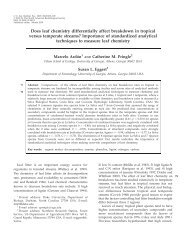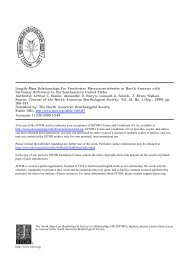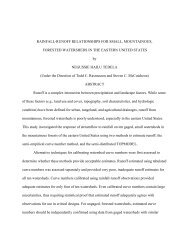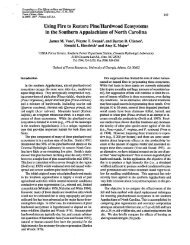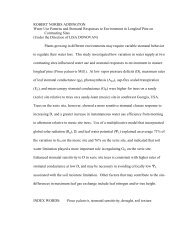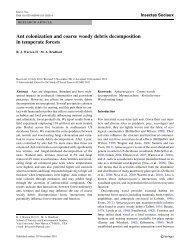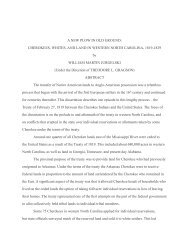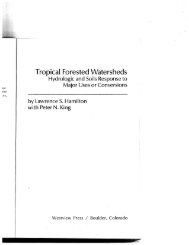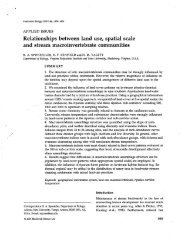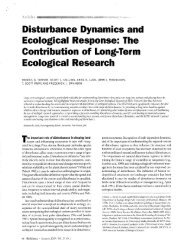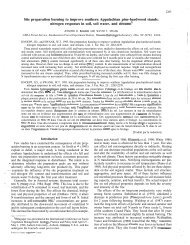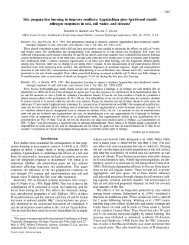biology join - Coweeta LTER - University of Georgia
biology join - Coweeta LTER - University of Georgia
biology join - Coweeta LTER - University of Georgia
You also want an ePaper? Increase the reach of your titles
YUMPU automatically turns print PDFs into web optimized ePapers that Google loves.
Articles<br />
Figure 1. Examples <strong>of</strong> the diversity <strong>of</strong> long-term experiments established or already ongoing in the earliest cohorts <strong>of</strong> sites<br />
(more than 20 years old; see table 1) in the Long Term Ecological Research (<strong>LTER</strong>) Network. (a) Small watersheds with<br />
different forest harvest treatments at the HBR site (photograph: Hubbard Brook Research Foundation); (b) snowfence<br />
experiment designed to alter soil moisture and growing-season length at the NWT site (photograph: Mark Williams, Niwot<br />
Ridge <strong>LTER</strong> Program, <strong>University</strong> <strong>of</strong> Colorado); (c) a long-term ungrazed exclosure (left) adjacent to a grazed grassland at the<br />
SGS site (photograph: Alan K. Knapp); (d) warming, nutrient addition, and shade experiments at the ARC site (photograph:<br />
Sarah E. Hobbie); (e) biodiversity manipulations at the CDR site (photograph: David Tilman); (f) watershed-scale fire<br />
experiments at the KNZ site (photograph: Alan K. Knapp). Site abbreviations are defined in table 1.<br />
(i.e., a single perturbation or manipulation event) was the<br />
most common type <strong>of</strong> experiment (Callahan 1984), such as<br />
deforestation studies at HBR and CWT or wind-disturbance<br />
studies at HRF. These studies were motivated by the need<br />
to develop or test theory in order to enable a deeper understanding<br />
<strong>of</strong> the ways in which key drivers altered ecosystem<br />
structure and function. The goal was to complement historical<br />
observations with knowledge and insight that were<br />
unattainable from traditional short-term experiments and<br />
space-for-time studies. Other experiments were initiated<br />
to understand the impacts <strong>of</strong> anthropogenic disturbances<br />
such as logging, grazing, and acid deposition. Although the<br />
initial focus was on disturbances, the more-recent trend is<br />
for long-term experiments to have stronger relevance to<br />
global-change drivers or to be linked explicitly to policy and<br />
major issues in natural-resource management (figure 3).<br />
The working group concluded that, given the number and<br />
diversity <strong>of</strong> long-term experiments in the <strong>LTER</strong> Network,<br />
Callahan’s (1984) vision <strong>of</strong> the <strong>LTER</strong> Network as one that<br />
could address the “ serious contradiction between the time<br />
scales <strong>of</strong> many ecological phenomena and the support to<br />
finance their study” (p. 363) has been fulfilled.<br />
Synergies between the <strong>LTER</strong> Network and long-term<br />
experiments<br />
Although long-term experiments have been supported by<br />
many other programs and have been conducted successfully<br />
at a wide range <strong>of</strong> sites around the globe, long-term<br />
experiments conducted at <strong>LTER</strong> sites have many important<br />
advantages. First, long-term measurements at <strong>LTER</strong> sites<br />
provide essential context for interpreting experimental<br />
responses. Long-term observations can also provide pretreatment<br />
and reference-system data, as well as the basis<br />
for identifying ecological surprises, such as extreme climatic<br />
events (Lindenmayer et al. 2010, Smith 2011). Such<br />
data are critical for interpreting experimental results over<br />
380 BioScience • April 2012 / Vol. 62 No. 4 www.biosciencemag.org



